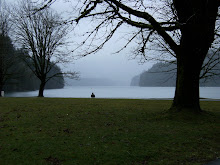We were on the B side of the range yesterday. Eight hours- shooting, shooting while moving and pivoting, moving in a tight stack with live weapons, target discrimination, entries with a team of mixed lethal and less-lethal weapons to engage a mix of threats: deadly threats; dangerous threats and hostages. It was a good shoot, even cold at seven yards nine of my first ten were in the two-inch square. Moving was almost as good. I threw several rounds while moving on the boardwalk- as complexity increases (shooting + moving + listening for commands + target discrimination + magazine changes and failure to fire drills + keeping your balance on a fairly narrow, slightly wiggly platform) it becomes easier to let little things slide, like, oh, the front sight. Still, even there the shooting was good- just not consistently the standard I need to put a round on the nose of a moving threat without hitting the hostage being used as a shield.
On the A side of the range the local contingent of a federal agency were qualifying. I watched one miss the paper, the two-foot by three foot paper, not just the large silhouette of a bad guy in the middle, three times out of three before the instructor came over to help. Shooting for a two inch pattern on the B side, happy to hit the paper at all on the A side.
At one point both sides of the range were cold, so we could take off our hearing protection and I heard the instructor on the other side order, "Load three magazines of six and put twelve loose rounds in your pocket." Wow. That means that they have not changed their qualification course since they gave up revolvers. Think about that. Lots of things don't change- human aggression really hasn't changed since before we became humans, the instinctive physical motions when threatened aren't that different either- the difference between an antelope bone and broken cue stick in actual application are negligible. Technology does change some things, however... and sometimes people don't change in response, even when the stakes are high. If you see an officer who carries his magazine pouch on the same side as his weapon, he has been taught to do that and probably told it was faster. And it was faster, back when we carried revolvers and had to switch the weapon to the other hand to pop the cylinder and use the speed-loaders.
I was a weaver shooter for decades. I'd seen the stats that people almost never blade their bodies under stress but I was sure that didn't apply to me. All those years and hours of practice surely made me a special case (you may laugh)... what convinced me was JJ pointing out a change in technology; "You realize that your stance points the biggest hole in your armor right at the bad guy, right?" Crap. Time to learn the modified isosceles and actually point my armor at the bad guy.
Aside- old pistol duelers advocated an elbow to hip, hand at shoulder stance side on to the opponent. If he did happen to hit the torso area with his pistol ball it would have to penetrate all three arm bones before getting to the ribs.
The tendency to not recognize when the world has changed and go with the original plan is really powerful. Sometimes people don't see the change. Sometimes they stay within their comfort zone of behavior. Sometimes it just seems that tradition and habit have a kind of weight and momentum. This combined with human ability to rationalize and a hefty dose of ego makes for some pretty poor decisions defended with rabid ferocity. It's funny, most of the time. But sometimes there is a real price.
I've written about training artifacts before- things that were introduced to make training safer that have become the "right way". The pronated fist in karate. The follow through in a judo throw. There are technology artifacts, too. If you have ever had the opportunity to take apart an old Filipino sword, the handle is no more than a piece of rattan pounded onto a rattail tang. So maybe, the flowing cuts of some of the styles are because the blade stays in the wound longer... or maybe it's because almost any other technique made the handle fall off. Maybe the curve in a katana is because it is some mathematical function of the way people's arms move when they slash... or maybe they never figured out how to use the folding technique on a straight blade (FWIW, some viking weapons were pattern-welded by braiding the softer and harder steels, but the vikings never figured out the differential tempering trick).
It's hard to step back and look at these things in your own stuff. Often, unless something is tested to destruction, the weak spots don't look like weak spots in training. When you do find one, however, it often leads to an entire new set of insights. When Bric pointed out that the magazine placement we had learned was based on the revolver, it got me thinking and led to a change in weapon retention- because that skill was also based on revolvers and revolver holsters and some of the techniques, such as turning your hip away when the weapon is grabbed from behind, actually gives up the third level of retention on a modern holster, making it easier for the bad guy.
Scrimshaw
-
Back in the day, when I didn't feel like writing but wanted to do something
creative, I decided to try my hand at scrimshaw.
Never got good at it, but I...
1 month ago


